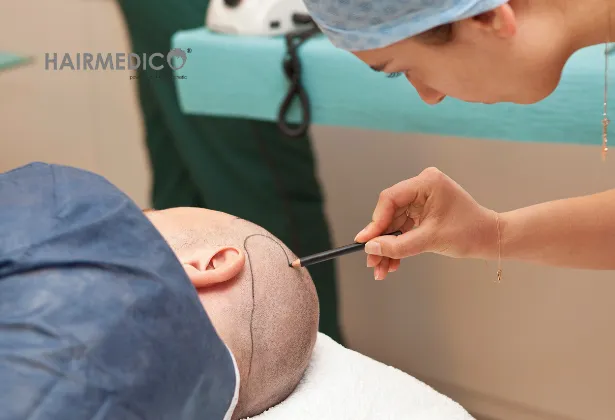
The donor area is one of the most critical factors in a successful hair transplant. It refers to the region of the scalp where healthy hair follicles are extracted before being implanted into balding areas. Understanding how the donor area works, how to protect it after surgery, and how to maximize graft survival can significantly impact the final results of your hair transplant.
In this article, we cover:
For expert advice on hair transplants, book a consultation at Hairmedico.
The donor area is the part of the scalp where hair follicles are extracted for transplantation. This area is usually located:
✔ At the back of the scalp (occipital region).
✔ On the sides of the head (parietal region).
These areas are ideal for hair transplantation because the follicles in these regions are genetically resistant to DHT, the hormone responsible for hair loss. This means that even when transplanted, these follicles will continue to grow naturally.
Two primary methods are used for extracting hair follicles from the donor area:
✔ Individual hair follicles are extracted one by one.
✔ Leaves no visible linear scars, making it ideal for people who prefer short hair.
✔ Faster healing time compared to FUT.
✔ Provides a natural, seamless look.
✔ A strip of scalp is removed, and follicles are extracted from it.
✔ Leaves a linear scar, which may be noticeable with short hair.
✔ Can yield a high number of grafts in one session.
For modern hair transplants, FUE is the preferred technique as it is less invasive and leaves no noticeable scars. Learn more about FUE vs. FUT techniques.
The number of grafts that can be safely extracted depends on:
✔ The density of your donor area – More hair means more available grafts.
✔ The size of the balding area – The larger the transplant area, the more grafts needed.
✔ The extraction method used – FUE allows for selective extraction, while FUT provides a high number of grafts.
A proper assessment by a specialist at Hairmedico can determine how many grafts you need.
No, once a follicle is extracted, it does not grow back. However, if the donor area is harvested correctly, the remaining hair covers the extracted spots, making it virtually undetectable.
To avoid over-harvesting and ensure a natural look, always choose a qualified hair transplant surgeon.
Proper post-surgery care ensures the donor area heals quickly and looks natural.
✔ Follow washing instructions – Use a mild shampoo and avoid scrubbing.
✔ Avoid touching or scratching the donor area to prevent irritation.
✔ Do not expose the area to direct sunlight for the first few weeks.
✔ Use prescribed medications to minimize swelling and discomfort.
✔ Consider PRP therapy to accelerate healing.
For detailed post-op care, visit Hairmedico’s aftercare guide.
Yes, but it depends on:
✔ How many grafts were taken in the first procedure.
✔ The remaining donor hair density.
✔ How well the donor area has healed.
A second transplant is possible, but an expert consultation at Hairmedico is necessary to determine donor area availability.
✔ Use hair supplements like Folliactiv to nourish and strengthen hair follicles.
✔ Avoid tight hairstyles that put stress on donor follicles.
✔ Eat a balanced diet rich in vitamins and proteins.
✔ Consider PRP therapy to improve scalp health and hair density.
Yes, body hair transplantation (BHT) is an alternative if the scalp donor area is insufficient.
✔ Beard hair – The second-best donor source after the scalp.
✔ Chest or back hair – Less commonly used due to differences in texture.
However, scalp donor hair remains the best option for natural-looking results.
✔ The quality of the donor area determines the success of the transplant.
✔ Proper extraction techniques ensure a natural look.
✔ Post-transplant care is essential for quick healing and long-term results.
If you’re considering a hair transplant, book a free consultation at Hairmedico today!